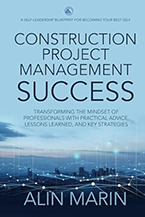March 11, 2025
Construction Project Management Success:
Transforming the Mindset of Professionals with Practical Advice, Lessons Learned, and Key Strategies
Alin Marin
Aviva Publishing (2025)
ISBN: 978-1-63618-367-1 (hardcover)
ISBN: 978-1-63618-371-8 (softcover)
ISBN: 978-1-63618-368-8 (ebook)
New Book Applies Project Management to Construction and to Life for Extra Success
 Alin Marin’s new book Construction Project Management Success: Transforming the Mindset of Professionals with Practical Advice, Lessons Learned, and Key Strategies is the perfect book for anyone who has a project to manage, wants to become a better leader, and specifically is in construction or wishes to become a better person all around.
Alin Marin’s new book Construction Project Management Success: Transforming the Mindset of Professionals with Practical Advice, Lessons Learned, and Key Strategies is the perfect book for anyone who has a project to manage, wants to become a better leader, and specifically is in construction or wishes to become a better person all around.
Marin has spent decades studying project management and then applying it in his career. He holds a bachelor’s degree in engineering and business management and a master’s in project management. He has worked on multi-billion-dollar construction megaprojects in mining, infrastructure, and liquefied natural gas. He has also experienced cultural diversity and how to work with people from a variety of cultures. Romanian by birth, Marin migrated to Australia at a young age, was educated there, and has dual Romanian and Australian citizenship. His career has taken him from working in Australia to Kazakhstan and Qatar. He has now shared his decades of knowledge and experience in his new book.
Construction Project Management Success is designed as a quick reference guide, although you can certainly read it from cover to cover. The book is divided into two sections: Project Management Key Knowledge Areas, which contains a one-chapter overview of the knowledge areas, and The Mindset of Project Management Success, which is divided into sixteen chapters on a wide range of topics. Topics include Embracing a Growth Mindset, Applying Situational Leadership, Making Strategic Decisions, Employing Effective Conflict Resolution, Navigating Intercultural Management, Protecting Your Body’s Energy, and Negotiating Win-Win Outcomes. Each chapter is designed to stand alone, so the reader can quickly turn to that chapter for whatever topic they want to learn more about or if they have a challenge they need advice on.
The individual chapters follow a similar format so information is easy to find. First, a general discussion of the topic is provided, followed by a section applying the topic specifically to construction. Then the chapter is divided into sections about pitfalls in that area, how to implement the chapter’s advice, and practical exercises. An added benefit is that while the opening sections of the chapters are in paragraph format, the rest are largely in bullet points and lists to provide quick-and-easy reference to whatever will help the reader. The Key Takeaways at the end of each chapter also help readers to find solutions quickly.
While I can’t discuss everything in this book, I’ll comment on a few of the nuggets that resonated with me. Marin has obviously read widely in the fields of project management, business, and personal development, so he offers numerous tools he’s learned from other sources. The result is that this book is a true encyclopedia of project management possibilities.
I appreciated Marin’s discussion of project scope management. Although I’m not in construction, I’ve had construction work done on my home and have some understanding of everything involved in managing a construction project. Marin discusses how to define, control, and manage the project to ensure project deliverables meet what the stakeholders want, while avoiding scope creep. He also discusses how when things go wrong, such as a supplier not being able to deliver when planned, efficient change management is needed to create alternative milestones and reschedule parts of the project.
Time management is another big topic that relates to project scope management and any project you attempt whether in construction or elsewhere. Marin discusses how effective time management requires prioritizing tasks, and he offers advice on how to do that so the most important tasks get done and we don’t waste our energy letting distractions keep us from getting our major goals accomplished. Tools Marin recommends include the Eisenhower Matrix, which helps people divide tasks into important and urgent, important but not urgent, important but urgent, and not important and not urgent.
In relation to time management, Marin discusses the importance of managing your energy so you can get what you want done when you want it done. He quotes Mark Twain’s advice, “Eat the frog first thing in the morning,” meaning tackle the most challenging or unpleasant task first. However, he also notes everyone has different times when their energy is highest so they should strive to accomplish their major tasks at that time, whatever time of the day it may be. Marin offers advice for managing energy by recommending you work in short bursts of action followed by rest, and also by creating positive rituals.
Perhaps the book’s most important discussion is the need to have a growth mindset. Without a growth mindset, you’re unlikely to read this book and want to make its advice work for you. As Marin says, “A growth mindset fosters resilience, adaptability, and lifelong learning.” A growth mindset means having a willingness to think outside the box, step out of your comfort zone, and gradually improve your skills so you can accomplish tomorrow what you may not be prepared to do today.
The discussion about cultural awareness is also relevant since we live in an increasingly diverse work world, often working beside or communicating via technology with people from around the world and from different cultures. Marin goes into detail about how different cultures prefer to work and communicate, offering many examples from cultures ranging from Japan and the United States to Australia and Kazakhstan. Ultimately, Marin states, “Cultural Sensitivity Is Crucial: It prevents misunderstandings and fosters an inclusive, cohesive work environment. Organizing cultural exchange workshops helps team members learn about each other’s backgrounds, reducing conflicts.” Reducing conflict is another entire topic in this book discussed with great practical advice and insight.
Without reservation, I can say that I believe everyone who reads this book, whether or not in construction—even if managing a daycare, working on a team project in college, or trying to manage a personal project—will find multiple tips to improve their work environment and their private lives. If you are ready to step outside of your comfort zone and set yourself up for future success in all your projects, then you don’t want to miss reading Construction Project Management Success.
For more information about Alin Marin and Construction Project Management Success, visit www.ConstructionProjectManagementSuccess.com.
— Tyler R. Tichelaar, PhD and award-winning author of The Mysteries of Marquette

